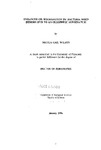ENHANCED OIL DEGRADATION BY BACTERIA WHEN IMMOBILIZED TO AN OLEOPHILIC SUBSTRATUM
| dc.contributor.author | WILSON, NICOLA GAIL | |
| dc.contributor.other | School of Biological and Marine Sciences | en_US |
| dc.date.accessioned | 2013-11-05T13:14:27Z | |
| dc.date.available | 2013-11-05T13:14:27Z | |
| dc.date.issued | 1996 | |
| dc.identifier | NOT AVAILABLE | en_US |
| dc.identifier.uri | http://hdl.handle.net/10026.1/2603 | |
| dc.description.abstract |
Three immobilization matrices, Biofix (kaolinite microspheres), Drizit (polypropylene fibres) and polyester polyurethane were used as substrata for use in bioremediation. Enhanced biodegradation of petrol (Slovene diesel) and Ekofisk crude oil occurred with immobilization of Pseudomonas fluorescens to Biofix and Drizit in freshwater and saltwater systems. When compared to free bacteria, immobilization resulted in; increased growth, accelerated ability of the cells to utilize oil, and enhanced biodegradation as determined by gas chromatography. In the freshwater systems Drizit immobilized cells reduced the lag phase to one day in comparison to six in a free system and increased biodegradation of the n-alkanes by 67 %. Immobilization resulted in enhanced production of a rhamnolipid biosurfactant over the first three days of incubation in comparison to free living bacteria which showed a lag phase of two days. All three supports were compared by; scanning electron microscopy, cell loading capacity, absorption of oil, their abilities to enhance oil biodegradation and the effect of drying and storage on the immobilized cells. Biodegradation of hydrocarbons by immobilized cells was dependent on the biocarrier, with polyurethane immobilized cells failing to enhance biodegradation of Ekofisk crude oil. Drizit was the most effective biocarrier tested and the most suitable immobilization substratum for use as a bioremediation agent. Investigation into the location of the genes for alkane degradation in immobilized Pseudomonas fluorescens was undertaken. Plasmid DNA was detected using gel electrophoresis, and caesium chloride-ethidium bromide gradient was carried out to confirm the presence of the plasmid, but no plasmid band was visualized. The successful immobilization system was scaled-up, optimized by supplementation with nitrates and phosphates and applied to microcosms that modelled environmental conditions. Enhanced biodegradation of Ekofisk crude oil was demonstrated on a larger scale, in an estuarine microcosm, with the immobilized systems showing an average degradation of 41.9 % in comparison to 7.1 % in the microcosm containing free indigenous bacteria. | en_US |
| dc.language.iso | en | en_US |
| dc.publisher | University of Plymouth | en_US |
| dc.title | ENHANCED OIL DEGRADATION BY BACTERIA WHEN IMMOBILIZED TO AN OLEOPHILIC SUBSTRATUM | en_US |
| dc.type | Thesis | |
| plymouth.version | Full version: final and full version as approved by the examiners at the time of the award of your degree | en_US |
| dc.identifier.doi | http://dx.doi.org/10.24382/4885 | |
| dc.identifier.doi | http://dx.doi.org/10.24382/4885 |
Files in this item
This item appears in the following Collection(s)
-
01 Research Theses Main Collection
Research Theses Main


